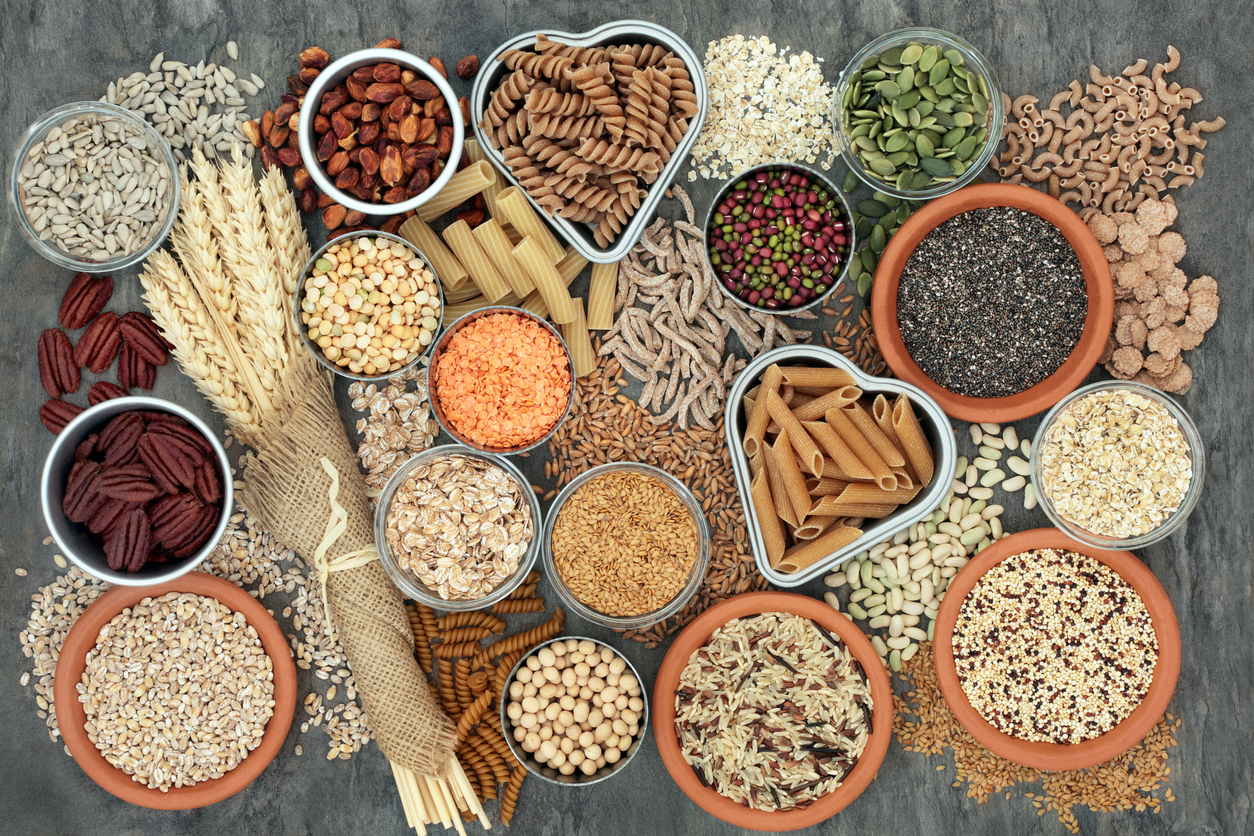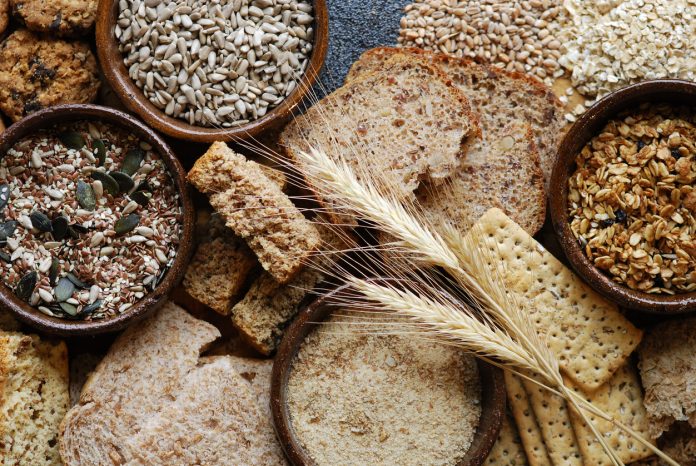According to WHO, cancer causes more deaths than any other illness around the world – even more than heart disease. However, research is now showing that cancer risks can be reduced by increasing the amount of fibre in the diet. Could this be true?
In the UK, 375,000 cancers are diagnosed every year – that’s around 1000 cancers per day. The most common cancers are lung, breast, colon, rectum and prostate.
Much research now shows that cancer risk can be reduced by increasing the amount of fibre in the diet. In a recent 2023 meta-analysis, the authors reviewed all the good quality, meta-analyses on dietary fibre intake and cancer risk, to date. They found that a high-fibre diet statistically significantly reduces the risk of cancers of the stomach, colon, rectum, colonic polyps, breast, endometrium, prostate, and pancreas.
Let’s take a look at their results more closely and think why this might be.
Battling stomach cancer by increasing fibre diets
The 2023 meta-analysis found that each 10g/day increase in fibre intake, resulted in a 44% reduction in gastric (stomach) cancer.
- Fibre blocks the action of nitrites taken in the diet (processed foods are a common source of nitrites) and prevents the formation of nitroso compounds which are known to be carcinogenic. Dietary fibre also lowers the concentration of nitrite in the stomach.
- Fibre contains ferulic acid and p-coumaric acid, both of which have anticancer effects, that impair the growth and development of cancer cells and speed apoptosis (the removal of dead and damaged cells).
- Fermented dietary fibre produces short-chain fatty acids (SFAs) which promote both cell differentiation and apoptosis.
- Other studies have shown that Allium vegetables (onions, garlic, leeks and chives) have an antibacterial action on Helicobacter pylori (H, pylori) infection – which is strongly linked to stomach cancer.
Colon and rectal cancer
The 2023 meta-analysis found a high-fibre diet reduced the risk of colon and rectal cancers by 26% and 23%, respectively. In addition, the risk of adenomatous polyps was reduced by 29%.
- Fibre bulks out the stool, exerting pressure on the bowel wall and ensuring intestinal contents pass through the GI tract with a suitable transit time. Too little fibre results in constipation, meaning faecal carcinogens (such as heterocyclic aromatic amines (HCA) and polycyclic aromatic hydrocarbons (PAH), are then in contact for longer with the colonic wall or sit for longer in the rectum.
- Fermentation of fibre in the bowel results in the production of SFAs, such as butyrate, which are protective against the development of colon or rectal cancer. They suppress abnormal cell growth and stimulate apoptosis.

Does higher fibre reduce breast cancer risk?
The 2023 meta-analysis showed that a high intake of dietary fibre reduced the risk of both pre and post-menopausal breast cancer by 18%. The effect was seen with both soluble and insoluble fibre.
- Having a large quantity of fibre in the gut reduces the absorption of oestrogen into the bloodstream.
- SFAs produced in the gut also have a protective effect on the development of breast cancer cells.
- Fibre binds to oestrogen and increases its excretion in the stools.
- High fibre in the diet reduces the risk of obesity. Obese women have higher oestrogen levels as oestrogen is produced in adipose tissue. Being obese after menopause increases the risk of breast cancer by 20%-60%.
Reducing endometrial cancer risks
The 2023 meta-analysis found that a high-fibre diet reduced the risk of endometrial cancer by 14%.
- Endometrial cancer is associated with high estrogen levels. The high fibre content in the gut increases the transit time of the intestinal contents, giving less opportunity for oestrogen absorption and for the reabsorption of bile acids which contain cholesterol metabolites, cholesterol being the precursor of estrogen.
- High-fibre diets are often associated with a lower glycaemic load and have a more favourable effect on insulin resistance and blood glucose levels. Better glucose control is linked to lower levels of systemic inflammation.
- A high-fibre diet is known to lower blood pressure and the risk of type-2 diabetes, both of which are risk factors for endometrial cancer.
Prostate cancer
The 2023 meta-analysis found a high-fibre diet reduced the risk of prostate cancer by 13%.
- Many studies have shown that a diet with a low fibre intake is a significant risk factor for prostate cancer. Foods such as soy, nuts, oils and seeds have been shown to have a protective effect.
- Prostate cancer has a much lower incidence and mortality in Asian populations compared to Western populations. One explanation for this may be that Westerners tend to eat a diet of highly processed foods which is less common in Asians. High-fibre foods such as cereals, legumes, nuts and soya contain high levels of inositol hexaphosphate, also known as phytic acid or IP6.
- IP6 has potent anticancer effects to inhibit cell growth and differentiation. When ingested it is rapidly absorbed in the gut and transported to malignant cells but does not affect normal tissues. In one 2013 lab study in mice, IP6 was shown to prevent angiogenesis in prostate tumours (blood vessel growth).
- Fibre is known to increase sex hormone binding globulin (SHBG) and improve insulin sensitivity, both of which are linked to less aggressive prostate cancer.
Reducing chances of kidney cancer with more fibre
The 2023 meta-analysis found a high-fibre diet reduced the risk of kidney cancer by 16%.
- Eating high-fibre foods leads to health improvements because it prevents constipation, improves the bacterial flora of the gut, and helps maintain the gut barrier, preventing toxins from getting into the bloodstream. High-fibre diets lower chronic inflammation.
- Fibre-rich plant foods often have a high antioxidant content. Antioxidants counteract dangerous free radicals and prevent DHA mutations which are the first step in the development of cancer. In one 2013 study, those with the highest fibre intake had a 15%-20% lower risk of kidney cancer (renal cell carcinoma).
Managing pancreatic cancer and a high-fibre diet
The 2023 meta-analysis found a high-fibre diet reduced the risk of pancreatic cancer by 37%.
- A high-fibre diet means the intestinal contents pass promptly through the gut, leaving less time for any carcinogens to come into contact with the gut wall.
- Increasing the amount of fibre in the diet is beneficial as it undergoes fermentation to produce cancer-protecting SFAs. As a result, the pH of the colon is lowered. A high stool pH increases the risk of bowel cancer. SFAs also prevent the growth of pathogenic organisms in the gut. They also lower chronic inflammation which lowers the risk of pancreatic cancer.
- Fibre improves insulin sensitivity and reduces the risk of type-2 diabetes – both of these are risk factors for pancreatic cancer.
Current recommendations for fibre in the diet
The NHS recommends UK adults consume 30 g of fibre per day. But the average UK adult only eats 20 g of fibre per day – well below this amount. Unfortunately, the nation’s intake of fruit and veg is far lower than it should be. In 2018, only 28% of the population were eating their 5 a day. This is especially common in young people aged 16-24 years.

How to get more fibre into your diet
Getting fibre in your diet is easy. Just look at the following tips –
- Start each day with a bowl of whole-grain cereal.
- Don’t eat ‘white foods’ such as white bread, rice or pasta. Swap to the brown alternatives.
- Get in the habit of snacking on nuts, and sprinkling nuts and seeds on fruit, yoghurt or adding them to smoothies. Chia seeds, for example, are packed full of fibre. Other good snacks are slices of raw carrot, fruit, hummus, avocado and whole grain crackers.
- Swap one or two meat meals a week for a veggie alternative. This will help achieve your 5 a day and has so many health benefits.
- Pile up the salad at mealtimes and eat more veg. Your plate should contain 50% veg or salad, 25% grains and 25% protein. Wash but leave the skin on vegetables as most of the fibre is in the skin. For example, the humble baked potato is high in fibre.
- Cook from scratch – avoid processed foods. Add lentils, chickpeas and beans to soups, casseroles and stews.
- Use wholegrain alternatives such as barley, buckwheat or quinoa.
- Eat popcorn – as this is actually a whole grain, but be careful not to overdo the salt or sugar.
- Sprinkle added fibre such as flax seed onto foods, or add ispaghula husk to baked goods.
For more information
- NHS – How to get more fibre in your diet
- British Nutrition Foundation – Fibre
This piece was written and provided by Dr Deborah Lee, Dr Fox Online Pharmacy











